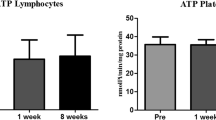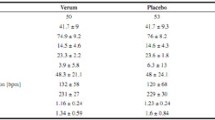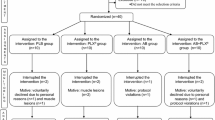Abstract
The aim of this study was to evaluate in sedentary individuals the effects of a 20-week exercise training program on ex vivo platelet responsiveness and the possible involvement of plasma antioxidant defences in relation to the mechanisms controlling platelet sensitivity. A statistically significant decrease in ADP- and collagen-evoked platelet aggregation was observed after physical training together with an increase in plasma total antioxidant capacity (TEAC), superoxide dismutase activity, and high-density lipoprotein cholesterol (HDL-C) concentration. Additionally, a rise in lag time for in vitro low-density lipoprotein (LDL) oxidation as well as a decreased plasma level of secondary products of lipid peroxidation were observed after training, and the values for lag time were significantly correlated with TEAC and HDL-C. Nitrate/nitrite (NOx) content both in plasma and in platelet cytosol was significantly enhanced at the end of the training period and a significant positive correlation was found between plasma and intraplatelet NOx values. Furthermore, intraplatelet NOx content was positively correlated with HDL-C levels. The findings of the current study suggest that the improvement of antioxidant defences induced by moderate regular exercise may be involved in desensitising blood platelets most likely through the inhibition of LDL oxidation and the simultaneous enhancement of plasma and intraplatelet NOx bioavailability and HDL-C level.




Similar content being viewed by others
References
Ashton T, Rowlands CC, Jones E, Young IS, Jackson SK, Davies B, Peters JR (1998) Electron spin resonance spectroscopic detection of oxygen-centred radicals in human serum following exhaustive exercise. Eur J Appl Physiol 77:498–502
Bergholm R, Makimattila S, Valkonen M, Liu ML, Lahdenpera S, Taskinen MR, Sovijarvi A, Malmberg P, Yki-Jarvinen H (1999) Intense physical training decreases circulating antioxidants and endothelium-dependent vasodilation in vivo. Atherosclerosis 145:341–349
Bode-Boger SM, Boger RH, Galland A, Frolic JC (1994) Exercise increases systemic nitric oxide production in men. J Cardiovasc Risk 1:173–178
Chen LY, Mehta JL (1994) Inhibitory effect of high-density lipoprotein on platelet function is mediated by increase in nitric oxide synthase activity in platelets. Life Sci 55:1815–1821
Chen HI, Li HT, Chen CC (1994) Physical conditioning decreases norepinephrine-induced vasoconstriction in rabbits: possible roles of epinephrine-evoked endothelium-derived relaxing factor. Circulation 90:970–975
Chen LY, Nichols WW, Hendricks J, Mehta JL (1995) Myocardial neutrophil infiltration, lipid peroxidation and antioxidant activity after coronary artery thrombosis and thrombolysis. Am Heart J 129:211–218
Chen LY, Metha P, Metha JL (1996) Oxidized LDL decreases l-arginine uptake and nitric oxide synthase protein expression in human platelets. Circulation 93:1740–1746
Crouse SF, O’Brien BC, Grandjean PW, Lowe RC, Rohack JJ, Green JS (1997) Effects of training and a single session of exercise on lipids and apolipoproteins in hypercholesterolemic men. J Appl Physiol 83:2019–2028
Dufaux BG, Assmann G, Hollmann W (1982) Plasma lipoprotein and physical activity: a review. Int J Sports Med 3:123–126
Durstine JL, Grandjean PW, Davis PG, Ferguson MA, Alderson NL, DuBose KD (2001) Blood lipid and lipoprotein adaptations to exercise: a quantitative analysis. Sports Med 31:1033–1062
Esterbauer H, Jurgens G, Quehenberger O, Koller E (1987) Autooxidant of human low density lipoprotein: loss of polyunsatured fatty acids and vitamin E and generation of aldehydes. J Lipid Res 28:495–509
Ferguson MA, Alderson NL, Trost SG, Essig DA, Burke JR, Durstine JL (1998) Effects of four different single exercise sessions on lipids, lipoproteins, and lipoprotein lipase. J Appl Physiol 85:1169–1174
Friedewald WT, Levy RI, Fredrickson DS (1972) Estimation of the concentration of low-density lipoprotein in plasma without the use of preparative ultracentrifuge. Clin Chem 18:499–502
Fukai T, Siegfried MR, Ushio-Fukai M, Cheng Y, Kojda G, Harrison DG (2000) Regulation of the vascular extracellular superoxide dismutase by nitric oxide and exercise training. J Clin Invest 105:1631–1639
Grandjean PW, Oden GL, Crouse SF, Brown JA, Green JS (1996) Lipid and lipoprotein changes in women following 6 months of exercise training in a worksite fitness program. J Sports Med Phys Fitness 36:54–59
Grisham MB, Johnson GG, Lancaster JR (1996) Quantitation of nitrate and nitrite in extracellular fluids. Methods Enzymol 268:237–246
Hassall DG, Forrest LA, Bruckdorfer KR, Marenah CB, Turner P, Cortese C, Miller NE, Lewis B (1983) Influence of plasma lipoproteins on platelet aggregation in a normal male population. Arterosclerosis 3:332–338
Hirayama A, Noronha-Dutra AA, Gorge MP, Neild GH, Hothersall JS (1999) S-nitrosothiols are stored by platelets and released during platelet-neutrophil interaction. Nitric Oxide 3:95–104
Jungersten L, Ambring A, Wall B, Wennmalm A (1997) Both physical fitness and acute exercise regulate nitric oxide formation in healthy humans. J Appl Physiol 82: 760–764
Kestin AS, Ellis PA, Barnard MR, Errichetti A, Rosner BA, Michelson AD (1993) Effect of strenuous exercise on platelet activation state and reactivity. Circulation 88:1502–1511
Lakka TA, Venalainen JM, Rauramaa R, Salonen R, Tuomilehto J, Salonen JT (1994) Relation of leisure-time physical activity and cardiorespiratory fitness to the risk of acute myocardial infarction. N Engl J Med 330:1549–1554
LeMura LM, von Duvillard SP, Andreacci J, Klebez JM, Chelland SA, Russo J (2000) Lipid and lipoprotein profiles, cardiovascular fitness, body composition, and diet during and after resistance, aerobic and combination training in young women. Eur J Appl Physiol 82: 451–458
Liu M, Bergholm R, Makimattila S, Lahdenpeira S, Valkonen M, Hilden H, Yki-Jarvinen H, Taskinen M (1999) A marathon run increases the susceptibility of LDL to oxidation in vitro and modifies plasma antioxidants. Am J Physiol 276:E1083–1091
Loscalzo J (2001) Nitric oxide insufficiency, platelet activation, and arterial thrombosis. Circ Res 88:756–762
Mackness MI, Arrol S, Durrington PN (1991) Paroxonase prevents accumulation of lipoperoxides in low-density lipoproteins. FEBS Lett 286:152–154
Maeda S, Miyauchi T, Kakiyama T, Sugawara J, Iemitsu M, Irukayama-Tomobe Y, Murakami H, Kumagai Y, Kuno S, Matsuda M (2001) Effects of exercise training of 8 weeks and detraining on plasma levels of endothelium-derived factors, endothelin-1 and nitric oxide, in healthy young humans. Life Sci 69:1005–1016
Miller NJ, Rice-Evans C, Davies MJ, Gopinathan V, Milner A (1993) A novel method for measuring antioxidant capacity and its application to monitoring the antioxidant status in premature neonates. Clin Sci 84:407–412
Misko TP, Schilling RJ, Salvemini D, Moore WM, Currie MG (1993) A fluorometric assay for the measurement of nitrite in biological samples. Anal Biochem 214:11–16
Naesh O, Hindberg I, Trap-Jensen J, Lund JO (1990) Post-exercise platelet activation-aggregation and release in relation to dynamic exercise. Clin Physiol 10:221–230
Node K, Kitakaze M, Sato H, Koretsune Y, Katsube Y, Karita M, Kosaka H, Hori M (1997) Effect of acute dynamic exercise on circulating plasma nitric oxide level and correlation to norepinephrine release in normal subjects. Am J Cardiol 79:526–528
Rauramaa R, Salonen JT, Seppänen K, Salonen R, Venäläinen JM, Ihanainen M, Rissanen V (1986) Inhibition of platelet aggregability by moderate-intensity physical exercise: a randomized clinical trial in overweight men. Circulation 74:939–944
Sanchez-Quesada JL, Ortega H, Payes-Romero A, Serrat-Serrat J, Gonzalez-Sastre F, Lasuncion MA, Ordonez-Llanos J (1997) LDL from aerobically trained subjects shows higher resistance to oxidative modification than LDL from sedentary subjects. Atherosclerosis 132:207–213
Shern-Brewer R, Santanam N, Wetzstein C, White-Welkley J, Parthasarathy S (1998) Exercise and cardiovascular disease. Arterioscler Thromb Vasc Biol 18:1181–1187
Superko HR, Haskell WH (1987) The role of exercise training in the therapy of hyperlipoproteinemia. Cardiol Clin 5:285–310
Tozzi-Ciancarelli MG, Penco M, Di Massimo C (2002) Influence of acute exercise on human platelet responsiveness: possible involvement of exercise-induced oxidative stress. Eur J Appl Physiol 86:266–272
Wang JS, Jen CJ, Chen HI (1995) Effects of exercise training and deconditioning on platelet function in men. Arterioscler Thromb Vasc Biol 15:1668–1674
Wang JS, Jen CJ, Chen HI (1997) Effects of chronic exercise and deconditioning on platelet function in women. J Appl Physiol 83:2080–2085
Wilson PWF, Paffenbarger RS, Morris JN, Havlik RJ (1986) Assessment methods for physical activity and physical fitness in population studies: report of a NHLBI workshop. Am Heart J 111:1177–1192
Author information
Authors and Affiliations
Corresponding author
Rights and permissions
About this article
Cite this article
Di Massimo, C., Scarpelli, P., Penco, M. et al. Possible involvement of plasma antioxidant defences in training-associated decrease of platelet responsiveness in humans. Eur J Appl Physiol 91, 406–412 (2004). https://doi.org/10.1007/s00421-003-0998-9
Accepted:
Published:
Issue Date:
DOI: https://doi.org/10.1007/s00421-003-0998-9




